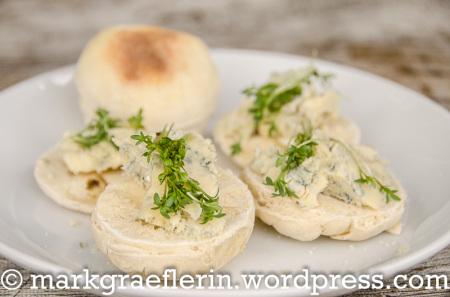
Vor Weihnachten sind wir am Kühlregal auf ein Tontöpchen mit “Blue Stilton” gestoßen, der im Vereinigten Königreich zur Weihnachtszeit zusammen mit Crackern als Dessertkäse gereicht wird.

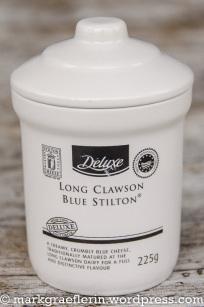
Blue Stilton ist ein englischer Blauschimmelkäse ähnlich dem italienischen Gorgonzola. Er schmeckt aber deutlich kräftiger beziehungsweise schärfer und ist von daher Geschmackssache. Der Käse eignet sich aber auch gut für Variationen von Spaghetti mit Gorgonzolasoße oder Makkaroni & Cheese.
Geschichte
Der Stilton wird in England als König der Käse angesehen und hat eine lange Tradition. Benannt ist er nach der Ortschaft Stilton in der mittelenglischen Grafschaft Cambridgeshire an der Postkutschenlinie Great North Road. Dort führte im 18. Jahrhundert Cooper Thornhill das Gasthaus Bell Inn. Im Jahre 1730 entdeckte Thornhill beim Besuch eines kleinen Bauernhofes bei Melton Mowbray in der Grafschaft Leicestershire einen sehr speziellen Blauschimmelkäse, der ihm so zusagte, dass er mit der Bäuerin Frances Pawlett einen Vertrag abschloss, der dem Bell Inn die Vermarktungsrechte des nachfolgend Blue Stilton genannten Käses exklusiv sicherte. Schon kurze Zeit später wurden über das Inn ganze Wagenladungen des Käses vertrieben, denn die Haupthandelsroute zwischen London und dem Norden Englands verlief über Stilton, so dass Thornhill den Käse optimal bewerben und verkaufen konnte und sich der besondere Ruf des Stilton sehr schnell im ganzen Land verbreitete. Heute wird der Stilton von sechs Molkereien gekäst, die in den Grafschaften Leicestershire, Derbyshire und Nottinghamshire angesiedelt sind. Stilton ist als Warenzeichen der Stilton Cheesemakers’ Association (SCMA) geschützt, der fünf der Produzenten angehören, außerdem genießt der Käse seit 1996 im gesamten EU-Rechtsraum den Status einer geschützten Ursprungsbezeichnung / PDO. (Quelle: Wikipedia)
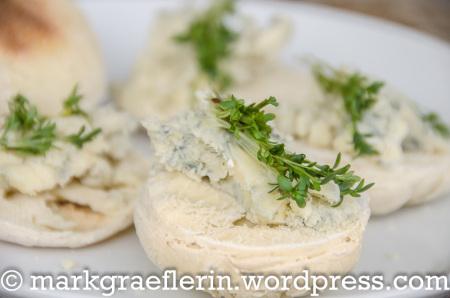
Devon Cut Rounds mit Stilton und frühlingsfrischer Kresse
Ich habe noch Devon Cut Rounds dazu gebacken – die sind ähnlich wie Scones, aber kaum gesüßt und daher ein hervorragender Begleiter für alle möglichen Käsesorten.
Das Originalrezept habe ich vor vielen Jahren aus England mitgebracht und jetzt endlich einmal ausprobiert.
Die berühmteste Devon Biskuit, der Half Moon, wurde 1826 von Bowden & Co von South Molton erschaffen und wird bis heute in der Stadt gebacken.
Cut-Rounds, in Exeter und Barnstaple beliebt und einfach zu machen, sind bodenständiger, eine Alternative zu Scones und ein guter Begleiter für viele der Käsesorten, die von den vierzehn verschiedenen Käsereien in Devon hergestellt werden. Sie können entweder mit Hefe oder Backpulver gemacht werden, um eine eher krümelige Struktur zu erreichen, oder sehr zäh wie diese.
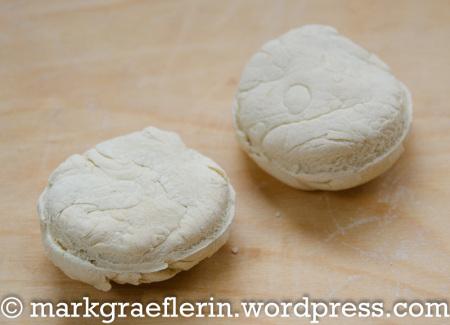
Devon Cut Rounds
Zutaten
(Für 12-15 Stück)
• 450 g Mehl
• 2 TL Backpulver
• 1 TL Zucker
• 1 TL Salz
• ca. 200 ml lauwarme Vollmilch
Die trockenen Zutaten zweimal sieben. Milch hinzufügen, untermischen und kneten, bis ein glatter, trockener Teig zu ensteht. 30 Minuten ruhen lassen.
Den Teig 2 cm dick aurollen, Kreise mit 6 cm Durchmesser ausstechen.
Die Kreise auf ein mit Dauerbackfolie belegtes Blech setzten. Nochmals 30 Minuten an einem warmen, trockenen Ort ruhen lassen.
Etwa 12 Minuten im vorgeheizten Ofen bei 200 °C backen, Gas Stufe 6.
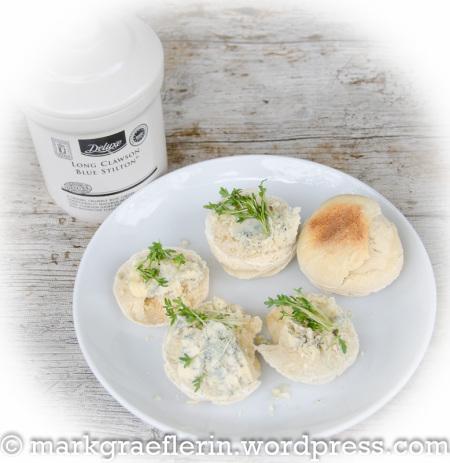
Devon Cut Rounds with Stilton
History
Both Blue Stilton and White Stilton have been granted the status of a protected designation of origin by the European Commission. The PDO status requires that only cheese produced in the three counties of Derbyshire, Leicestershire, and Nottinghamshire and made according to a strict code may be called “Stilton”; thus cheese made in the village of Stilton cannot be called “Stilton”.
According to the Stilton Cheesemaker’s Association, the first Englishman to market Blue Stilton cheese was Cooper Thornhill, owner of the Bell Inn on the Great North Road, in the village of Stilton, Huntingdonshire. Traditional legend has it that in 1730, Thornhill discovered a distinctive blue cheese while visiting a small farm near Melton Mowbray in rural Leicestershire – possibly in Wymondham. He fell in love with the cheese and made a business arrangement that granted the Bell Inn exclusive marketing rights to Blue Stilton. Soon thereafter, wagon loads of cheese were being delivered to the inn. Since the main stagecoach routes from London to Northern England passed through the village of Stilton he was able to promote the sale of this cheese and the fame of Stilton rapidly spread.
However, the first known written reference to Stilton cheese actually predates this and was in William Stukeley’s Itinerarium Curiosum, Letter V, dated October 1722. Daniel Defoe in his 1724 work A tour thro’ the whole island of Great Britain notes, “We pass’d Stilton, a town famous for cheese, which is call’d our English Parmesan, and is brought to table with the mites, or maggots round it, so thick, that they bring a spoon with them for you to eat the mites with, as you do the cheese.”
Frances Pawlett (or Paulet), a “skilled cheese maker” of Wymondham, has traditionally been credited as the person who set modern Stilton cheese’s shape and style characteristics in the 1720s, but others have also been named. The recipe for a Stilton cheese was published by Richard Bradley, first Professor of Botany at Cambridge University in his 1726 book A General Treatise of Husbandry and Gardening. Bradley records a letter from a correspondent, John Warner, which states the cheese is made in Stilton and that the Bell Inn produced “the best cheese in town”.
In 1936 the Stilton Cheesemakers’ Association (SCMA) was formed to lobby for regulation to protect the quality and origin of the cheese, and in 1966 Stilton was granted legal protection via a certification trademark, the only British cheese to have received this status. (Source: Wikipedia)
The most famous commercial Devon biscuit, the Half Moon, was created in 1826 by Bowden & Co of South Molton and is till being baked professionally in the town.
Cut Round, popular in Exeter and Barnstaple and simple to make, are more homespun, an alternative to scones and a good accompaniment for many of the cheeses which are being made by the fourteen different cheese makers in Devon.
They can be made either with yeast or baking powder to achieve a short and crumbly texture, or be quite chewy as here.
Devon Cut Rounds
Makes 12-15
450 g flour
2tsps baking powder
1tsp caster sugar
1tsp salt200ml approx. tepid unskimmed milk
Sift the dry ingredients twice. Add the milk, mix in and knead to form a smooth, dryish dough. Rest 30 minutes.
Roll out to 2cm thickness, cut out 6cm circles. Line a baking sheet with silicone paper.Put the circles on the sheet and rest 30 minutes in a warm dry place. Bake roughly 12 minutes in a hot oven 200c, gas mark 6.
Schlagwörter: Bell Inn, Blue Stilton, Cambridgeshire, cheese, Christmas, Cracker, Devon, Devon Cut Rounds, England, Food, Käse, Kresse, Leicestershire, recipe, Rezept, Stilton, Weihnachten
This entry was posted on 20. Januar 2016 at 20:44 and is filed under Backen, Dessert, Englisch, Essen & Trinken, Food, Fotografie, Grossbritannien, Reisen, Rezepte, Winter. You can follow any responses to this entry through the RSS 2.0 feed. You can leave a response, or trackback from your own site.


